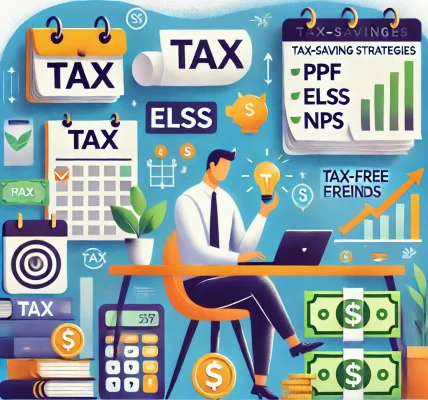Introduction
Filing Income Tax Returns (ITR) is a crucial financial responsibility for every taxpayer in India. Ensuring an error-free filing process not only saves time but also helps avoid penalties and legal issues. Even minor mistakes in your ITR can lead to notices from the Income Tax Department or delays in refunds.
This guide will walk you through the step-by-step process of filing your ITR accurately, highlight common mistakes to avoid, and provide expert tips for a smooth and hassle-free tax filing experience.
1. Understanding Different ITR Forms
Before filing your returns, it is essential to select the right ITR form based on your income source.
| ITR Form | Applicable For |
|---|---|
| ITR-1 (Sahaj) | Salaried individuals, pensioners, income from one house property, and other sources (interest, dividends) |
| ITR-2 | Individuals and HUFs with income from capital gains, multiple house properties, or foreign income |
| ITR-3 | Professionals and business owners (excluding presumptive income scheme) |
| ITR-4 (Sugam) | Individuals, HUFs, and firms opting for the presumptive income scheme under sections 44AD, 44ADA, or 44AE |
| ITR-5 | LLPs, Firms, and AOPs |
| ITR-6 | Companies (excluding those claiming exemption under section 11) |
| ITR-7 | Trusts, Political Parties, Charitable Institutions |
Choosing the wrong form can result in rejection or revision of your return.
2. Step-by-Step Guide to Filing ITR Online
Step 1: Gather Required Documents
Before starting the filing process, ensure you have the following documents:
- PAN Card & Aadhaar Card (mandatory for e-verification)
- Form 16 (for salaried individuals)
- Form 26AS (to verify TDS deductions)
- Bank Statements (for interest income verification)
- Investment Proofs (PPF, ELSS, LIC, etc. for claiming deductions under 80C, 80D, etc.)
- Capital Gains Statements (if applicable)
Step 2: Log in to the Income Tax e-Filing Portal
- Visit www.incometax.gov.in
- Log in using PAN/Aadhaar and password
- Select “e-File” > “File Income Tax Return”
Step 3: Choose the Correct Assessment Year & Filing Type
- For FY 2024-25, choose AY 2025-26
- Select “Online Mode” for an easier guided process
Step 4: Select the Appropriate ITR Form
- Based on your income source, select the relevant ITR form (as mentioned in the table above)
Step 5: Fill in Income & Deduction Details
- Enter salary, business income, interest income, rental income, or capital gains
- Claim deductions under Section 80C (PPF, ELSS, LIC), 80D (Health Insurance), 80E (Education Loan), etc.
- Ensure TDS details match Form 26AS
Step 6: Verify Tax Calculation & Pay Additional Tax (if any)
- The system auto-calculates tax liability or refund
- If tax is payable, make payment via Challan 280 and enter BSR code & challan number
Step 7: Preview & Submit the ITR
- Double-check all details before submission
- Click “Submit” to file your return
Step 8: E-Verify Your ITR
- Use Aadhaar OTP, Net Banking, or DSC to verify
- If not e-verified, send the signed ITR-V to CPC Bangalore within 120 days
3. Common Mistakes to Avoid While Filing ITR
A. Incorrect Personal Details
- Ensure PAN, Aadhaar, Name, and Address match official records
- Use a valid email and mobile number for OTP verification
B. Selecting the Wrong ITR Form
- Choosing the incorrect form can lead to rejection of the return
- Use ITR-1 only if income is from salary, one house property, and other sources
C. Mismatch in Income and Form 26AS
- Always cross-check income and TDS details with Form 26AS
- If discrepancies exist, ask the deductor to update the TDS return
D. Not Reporting All Sources of Income
- Include freelancing income, fixed deposit interest, capital gains, and rental income
- Non-reporting can attract a scrutiny notice from the IT Department
E. Incorrect Claim of Deductions
- Do not claim deductions without valid proof (investment receipts, medical bills, etc.)
- Ensure 80C, 80D, 80E deductions are correctly entered
F. Not Verifying ITR After Filing
- If ITR is not verified within 120 days, it is considered invalid
- Prefer Aadhaar OTP or Net Banking for instant verification
G. Missing the Due Date
- Last date for filing ITR for FY 2024-25 is 31st July 2025 (unless extended)
- Late filing attracts penalties up to ₹10,000 under Section 234F
4. ITR Filing for Different Types of Taxpayers
| Taxpayer Type | Important Considerations |
| Salaried Individuals | Form 16, House Rent Allowance (HRA), Standard Deduction |
| Freelancers | Declare business income, deduct expenses (laptop, internet, etc.) |
| Senior Citizens | No tax up to ₹5 lakh, higher deduction under 80D & 80TTB |
| Business Owners | GST returns, Profit & Loss statements required |
| NRIs | Only Indian income is taxable, check DTAA benefits |
5. What to Do If You Make a Mistake in ITR?
If you have already filed your return but later realize an error, you can rectify it by:
- Filing a Revised Return (u/s 139(5)) before 31st December 2025
- Filing an Updated Return (u/s 139(8A)) if you missed something earlier
- Responding to IT Notices if you receive a mismatch or verification request
Conclusion
Filing your Income Tax Return (ITR) correctly helps you avoid penalties, claim rightful refunds, and stay compliant with the law. By following the step-by-step guide, ensuring accuracy in income details, and verifying your ITR on time, you can make the process stress-free




